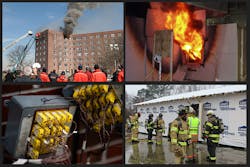Pennington: What Does All of This New Fire Research Mean?
While various findings from new fire science research have taken over as the hot topics at conferences, in articles, and shared through social media, it has exposed a few problems that are being seen on firegrounds around the world. These include the time it takes to get water to the fire and other basic skills that make it happen. That’s right, you heard it here first, sort of. It's that the basic fireground functions are still the number one contributing factor to the successful rescue, suppression, or exposure control operations. Does this mean that the research from UL, NIST, and Kill the Flashover are not relevant? Absolutely not! They all could be, quite possibly, the most important information provided to us around the new fire dynamics.
Understanding new terms such as flowpaths, cooling the environment, and proper size-up are all key things we should take away from this groundbreaking research. "Water doesn’t push fire" and "spraying water on smoke does not bathe you in larger amounts of steam" are two of the things that stand out the most to this jumpseat rider.
Dispelling these myths has changed the way that I look at interior firefighting. I think we all can remember a fire that was black and hot with visible fire showing that we should have taken the advice and cooled the environment, right? I know that I can say it happened not to long ago.
So how does this research prove that a solid base set of skills is needed? It proves the point that cooling the fire from the safest location while keeping it ventilation-limited will allow us to go inside and get the job done while reducing our exposure to high heat levels and pre-flashover conditions. Does this mean we are not interior firefighters? Nope. It means that we are using science to cool the inside before we go in.
More than anything this research has proven that the time to get water on the fire needs to happen quickly. You need to arrive on scene, complete the 360, and get the water flowing, now! How does this happen quickly? It should happen quickly because you are jumpseat ready to make it happen. Constant and consistent drilling should be done before the alarm sounds for you to be able to get off the truck, pull the appropriate line, make the stretch and get water on the fire, with the direction of our officers.
Making a stretch and flowing water isn’t a drill for just rookies. It should be practiced over and over by all firefighters, young and old. With today's staffing challenges and younger ranks with less experience, it may require a chief officer to pull the hose and make the stretch.
We all should take the time to listen and learn the lesson from these great folks that are branching out, dispelling myths, and giving us data to use on the fireground. It’s our job to listen in, ears open, and apply them to our fire scenes. Basic skills put fires out and saves lives. Don’t ever get back to the basics, never leave them!
Bunker up, buckle in, it’s where we all begin!
See Ryan Live! Ryan Pennington will be presenting several classes at Firehouse Expo, July 15-19 in Baltimore. Join him for "30 Ways to Stay Jumpseat Ready for Your Next Fire!" and "Identify, Adjust and Attack: A Tactical Approach to Hoarding Fires." He will co-presenting "Communications Between the Front Seat and the Jump Seat" with Lt. Michael Daley.
